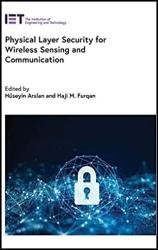 Название: Physical Layer Security for Wireless Sensing and Communication
Название: Physical Layer Security for Wireless Sensing and CommunicationАвтор: Huseyin Arslan, Haji M. Furqan
Издательство: The Institution of Engineering and Technology
Год: 2023
Страниц: 386
Язык: английский
Формат: pdf (true)
Размер: 31.7 MB
Wireless physical layer (PHY) security has attracted much attention due to the broadcast nature of the wireless medium and its inherent vulnerability to eavesdropping, jamming, and interference.
Physical Layer Security for Wireless Sensing and Communication covers both communication and sensing security from a broad perspective. The main emphasis is on PHY security, although other security measures are covered for the sake of completeness and as a step towards cross-layer security and cognitive security vision. After discussing the features of wireless channels from both the communication and sensing perspectives, the book details their exploitation for secure transmission utilizing various approaches. Wireless sensing and radio environment concepts are also addressed, along with the related security implications in terms of eavesdropping, disruption, manipulation, and, in general, the exploitation of wireless sensing by unauthorised users. Several solutions for these threats from the domains of wireless communication, military radars, and machine learning, are discussed.
The fifth generation (5G) of mobile communication signaled a paradigm shift in wireless networks by introducing a variety of services satisfying different performance requirements rather than concentrating on increasing the achievable data rates. As a result, enhanced mobile broadband (eMBB), massive machine-type communication (mMTC),and ultra-reliable low-latency communication (uRLLC) services were introduced to support a large number of devices and critical applications. Sixth-generation (6G) cellular communication standards intend to broaden this variety of applications and use cases even further, laying the groundwork for a human-centric digital society.
The book provides valuable information to researchers in academia and industry, as well as engineers, developers, and advanced students in the field of cybersecurity.
The summary of each chapter is as follows:
Chapter 1 starts off the book by envisaging what the next-generation networks could look like and highlights the need for secure wireless transmissions. A general overview of cryptography, its limitations, and the ability of PLS to solve these issues is then presented, thereby laying down the foundation for more detailed PLS discussions in the forthcoming chapters.
Chapter 2 introduces information theory, followed by the basics of PLS via the established information theory framework. Then, a classification of developed PLS techniques considering main approaches and attacks is presented. This chapter aims to be a technical introduction to PLS,its techniques, and performance evaluation approaches.
Chapter 3 expands the scope of PLS to safeguarding the entire wireless environment. A generalized framework that encompasses the different PLS approaches is introduced. This framework splits the PLS fabric into observation and modification planes.
Chapter 4 revisits the role of the wireless channel on PLS. The chapter first delves into the basic channel exploitation approaches for PLS. Owing to the fact that not every channel feature can be suitable for PLS applications, the chapter establishes and discusses the main criteria that must be considered while selecting a certain channel feature for PLS.
Chapter 5 presents the analog domain PLS mechanisms in wireless communication networks based on the transceivers’ hardware, known as physical layer authentication (PLA). First, PLA and its metrics are introduced. Then, the PLA techniques using radio frequency (RF) hardware components are deeply discussed, where PLA attributes are extracted and used jointly or separately to provide an accurate authentication process. Finally, new unique attributes are exploited for PLA in 5G communication systems including beam pattern and channel sparsity. To this end, some critical discussion is raised to explore the research challenges of PLA mechanisms for next-generation wireless networks.
Chapter 6 presents an upcoming archetype incorporating context-awareness for PLS. Context or situation awareness indicates a level of knowledge of the underlying phenomenon occurring at a given time and/or location. The variety of wireless devices, their capabilities, and limitations, along with their applications or usage areas render the classical one-size-fits-all approach to security infeasible and inefficient. Wireless sensing and the increasing implementations of Artificial Intelligence (AI)/Machine Learning (ML) in wireless networks have facilitated the possibility of tailored security mechanisms based on device capabilities, quality of security (QoSec) requirements, applications, and environments.
Chapter 7 presents an overview of the inherent security characteristics provided by different waveforms and the control channel signals against different security attacks. When these two fail or when higher security levels are required, PLS enters the picture.
Chapter 8 continues the examination of the modification plane by discussing the secure resource allocation (RA) and scheduling approaches and their popular methodologies...
Chapter 14 discusses the utilization of ML techniques in PLS. After providing some background on ML, this chapter highlights selected use cases for PLS, including signal relation-based physical layer authentication (PLA), identification of multiple RF impairments, cognitive radio security, and IoT security.
Chapter 15 discusses the implementation of quantum technology, which is advancing quickly in communications networks. In particular, Quantum Key Distribution (QKD) and Quantum Random Number Generation (QRNG) have become key applications for cryptography and physical layer security.
Скачать Physical Layer Security for Wireless Sensing and Communication